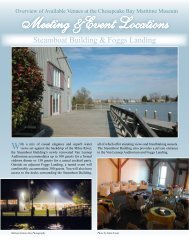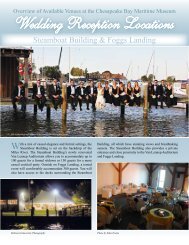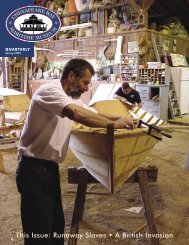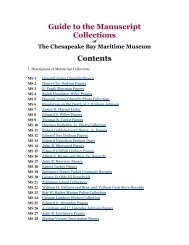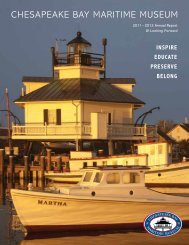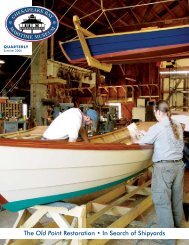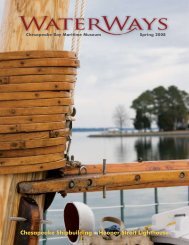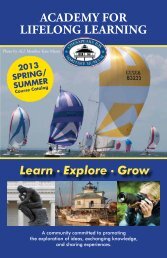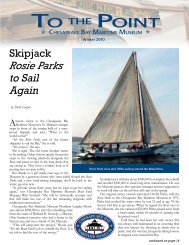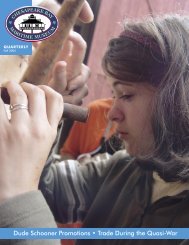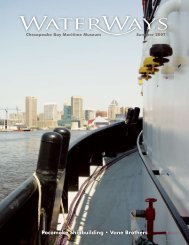Fall 2008 - Chesapeake Bay Maritime Museum
Fall 2008 - Chesapeake Bay Maritime Museum
Fall 2008 - Chesapeake Bay Maritime Museum
Create successful ePaper yourself
Turn your PDF publications into a flip-book with our unique Google optimized e-Paper software.
the U.S. Geological Survey Patuxent Wildlife Research<br />
Center in Laurel, Md. She worked with the local Sierra<br />
Club to create an environmental radio project called “Watershed<br />
Radio.”<br />
Buckley met Brown when she delivered the first demo<br />
of Watershed Radio to WRNR. Buckley brought up the idea<br />
for a recurring <strong>Chesapeake</strong>-based radio show, which led to a<br />
number of brainstorming meetings about possible guests and<br />
a format for the show. Brown suggested the name, “Voices of<br />
the <strong>Chesapeake</strong> <strong>Bay</strong>” for the series, and the group began with<br />
10 hour-long interviews.<br />
They decided on in-the-field style interviews, going to visit<br />
watermen, conservationists, and musicians in their element.<br />
“I do not remember us ever mapping out a strategy for<br />
how to tell the story of the <strong>Chesapeake</strong> <strong>Bay</strong> from beginning<br />
to end,” says Buckley in the epilogue to his book. “We just<br />
tried to think of people who had good stories to tell.”<br />
To date, the Voices Project has recorded more than 250<br />
oral history interviews with folks of all walks on the <strong>Bay</strong>.<br />
The diversity of perspectives and viewpoints represented is a<br />
point of pride for Buckley.<br />
“The thing I like to communicate about the Voices Project<br />
is the scope of the interviews, this method of telling stories<br />
about the <strong>Bay</strong> by seeking out a variety of perspectives,” he<br />
says. “We all tend to see life through our own particular interests.<br />
This project encourages people to look beyond themselves,<br />
to see the <strong>Bay</strong> through other eyes.”<br />
The Voices book showcases more than 50 of the interviews<br />
(three of which are excerpted here for WaterWays<br />
Magazine), illustrated with black-and-white photographs by<br />
renowned photographer David Harp. Buckley and publisher<br />
Lenny Rudow can often be found taking the book on the road<br />
to festivals, fish fries, crab feasts, and other gatherings where<br />
people come together to celebrate the <strong>Chesapeake</strong>.<br />
It was through his radio show that CBMM first encountered<br />
Buckley. His interviews with Curator Pete Lesher and<br />
former Boat Yard Manager Mike Vlahovich, which aired on<br />
WRNR, both appear in the book. And as CBMM was de-<br />
Photo by David Harp<br />
Russell Train<br />
Former Administrator,<br />
US Environmental Protection Agency<br />
Nixon was an enigma and he was strange in many<br />
ways, brilliant in many ways, effective in many<br />
ways and a disaster. He was his own worst enemy,<br />
certainly the whole Watergate fiasco was an example<br />
of that. When you’re at the pinnacle, you’re<br />
vulnerable. Maybe it’s a good lesson for the rest of<br />
us. Nixon was certainly not an environmentalist.<br />
I’ve got to say, I don’t think he understood many<br />
of the issues very well. However he knew one<br />
thing about it and that was that the people of this<br />
country were worried about the environment. I’m<br />
talking about the late 60s and the early 70s. The<br />
people of this country were worried. There were<br />
huge oil spills, there were rivers catching on fire,<br />
toxic chemical poisonings, a lot of things. It was<br />
very scary. There was rudimentary regulation;<br />
much of it was left to the states to handle. And it<br />
was plain that the federal government had to get<br />
more actively into the whole thing. Nixon seized<br />
on it. He made it a central effort of his administration,<br />
certainly in his first term. It was not only a<br />
political choice on his part, in that sense. It was a<br />
Democratic Congress whose environmental leader<br />
was Edmund Muskie. Nixon recognized Muskie as<br />
a potential Democratic candidate against him in<br />
1972. Muskie’s track record for the public was basically<br />
dealing with air and water pollution. Nixon<br />
made up his mind he was going to trump Muskie<br />
with his own issue, and I think he did. Hah—he<br />
‘stole his clothes!’ I think somebody said that, and<br />
I think it’s quite true.<br />
“Whatever the motivations were, Nixon<br />
grabbed the issue. He signed the National Environmental<br />
Policy Act into law on January 1, 1970<br />
as his first official act of the decade. A few days<br />
later he sent his State of the Union message to<br />
the Congress, and at least a third of that message<br />
dealt with the environment.<br />
17



